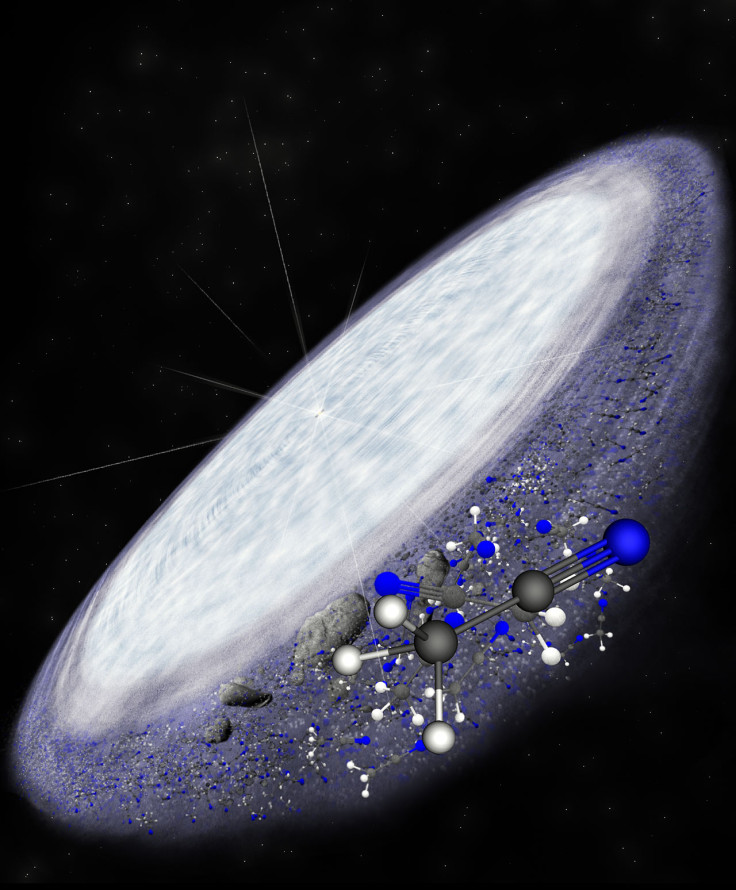Abundant organic molecules in young star shows conditions of life are universal

The chemical building blocks of life are probably universal going by the discovery of complex organic molecules found in dust around a distant young star.
The detection of large amounts of methyl cyanide around the young star MWC 480 was made with the Atacama Large Millimeter/submillimeter Array (Alma).
It reaffirms the belief that conditions that spawned the Earth and Sun, and life on Earth are not unique in the Universe.
The results are published in the 9 April 2015 issue of the journal Nature.
Cyanides, and especially methyl cyanide, are important because they contain carbon–nitrogen bonds essential for the formation of amino acids that go to build proteins and the building blocks of life.
The dust around the star contains enough methyl cyanide (CH3CN) to fill all of Earth's oceans, says an ESO release.
This complex carbon-based molecule and a simpler carbon compound hydrogen cyanide were found in the cold outer reaches of the star's newly formed disc, which astronomers believe is similar to the Kuiper Belt beyond Neptune that hosts comets and mini-planets in our own Solar System.
The molecules found in MWC 480 are also found in similar concentrations in the Solar System's comets. The Philae lander had detected organic molecules in the coma of the comet 67P.
Comets and asteroids are remnants of the early planet formation period and are sometimes thought to have seeded the young Earth with water and organic molecules required to kick-start life.
"Studies of comets and asteroids show that the solar nebula that spawned the Sun and planets was rich in water and complex organic compounds," noted Karin Öberg, an astronomer with the Harvard-Smithsonian Center for Astrophysics in Cambridge, Massachusetts, USA, and lead author of the new paper. "We now have even better evidence that this same chemistry exists elsewhere in the Universe, in regions that could form solar systems not unlike our own."
Now we know we’re not unique in organic chemistry. Once more, we have learnt that we’re not special. From a life in the Universe point of view, this is great news.
The star MWC 480, which is about twice the mass of the Sun and just a million years old, is located 455 light-years away in the Taurus star-forming region. Its surrounding disc is in the very early stages of development and astronomers have yet to detect any obvious signs of planet formation in it.
While cold, dark interstellar clouds have been known to be efficient factories for complex organic molecules, including cyanides, astronomers were not sure if these same complex organic molecules and their bonds can survive in the turbulent energetic environment of a newly forming solar system.
The latest discovery shows that the molecules flourish in such environments too.
In fact, there is an abundance of molecules in the dust which is much more than seen in interstellar clouds.
This indicates that protoplanetary discs are very efficient at forming complex organic molecules and they can form them quickly enough to outpace opposing forces.
"From the study of exoplanets, we know the Solar System isn't unique in its number of planets or abundance of water," Öberg said and added, "Now we know we're not unique in organic chemistry. Once more, we have learnt that we're not special. From a life in the Universe point of view, this is great news."
Alma was able to detect the faint millimetre-wavelength radiation that is naturally emitted by the molecules in space when the telescope was in its lower-resolution configuration.
Using its full capabilities Alma can reveal additional details about the chemical and structural evolution of stars and planets.
The molecules were however detected at 4.5 billion to 15 billion kilometres from the central star. This would be in the comet-forming zone of the star.
© Copyright IBTimes 2025. All rights reserved.





















